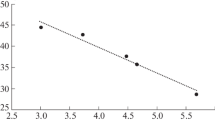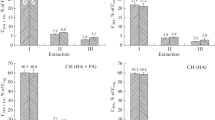Summary
During incubation of an acid cambisol and an alkaline fluvisol, amended with glucose and nitrate, hot water soil extracts were analysed for N content, ultraviolet absorption, and fluorescence. Humic substances in the hot water extracts and in a neutral sodium pyrophosphate extract were fractionated on polyvinylpyrrolidone and measured spectroscopically. Changes in the hot water and pyrophosphate extract compositions were related to changes in microbial biomass, as estimated by substrate-induced respiration, and the hexosamine content of soil hydrolysates. During the incubation, the microbial population in each type of soil developed quite differently, according to the soil pH. Microbial growth and death in the alkaline soil sample induced a maximum of hot-water-extractable ultraviolet-absorptive non-fluorescent substances. The fluorescence of the hot water soil extract increased steadily with incubation time even after the microbial activity was reduced. A similar increase in fluorescence, in accord with the ultraviolet absorption, was found during incubation of the acid soil samples. After 95 days of incubation, the hot-water-extractable fluorescent and ultraviolet-absorptive substances were reduced. N immobilization induced an increase, and N mineralization a decrease, in dissolved organic N. The relative increase in humic substances in the hot water soil extract was much higher than in the pyrophosphate extract. Therefore, humic material, produced by microbial growth and death, is obviously extractable with hot water.
Similar content being viewed by others
References
Aiken GR, Thurman EM, Malcolm RL (1979) Comparison of XAD macroporous resins for the concentration of fulvic acid from aqueous solutions. Anal Chem 51:1799–1803
Anderson JPE, Domsch KH (1978) A physiological method for the quantitative measurement of microbial biomass in soils. Soil Biol Biochem 10:215–221
Behm R (1988) Untersuchungen zur Bestimmung der leicht umsetzbaren N- und C-Anteile im Heißwasserextrakt des Bodens. Arch Acker-Pflanzenbau Bodenkd 32:333–335
Bonde TA, Rosswall T (1987) Seasonal variation of potentially mineralizable nitrogen in four cropping systems. Soil Sci Soc Am J 51:1508–1514
Bronner H, Bachler W (1979) Der hydrolysierbare Stickstoff als Hilfsmittel für die Schätzung des Stickstoffnachlieferungsvermögens von Zuckerrübenböden. Landwirtsch Forsch 32:255–261
Crowther AB, Large RS (1956) Improved conditions for the sodium phenoxide-sodium hypochlorite method for the determination of ammonia. Analyst 81:64–65
Danneberg OH, Kandeler E, Wenzl W (1988) Zusammenhänge zwischen der Mikroflora, dem Mineralstickstoff und den Fraktionen des “heißwasserlöslichen” Stickstoffs im Boden. In: VDLUFA-Schriftenreihe (ed) Verband Deutscher Landwirtschaftlicher Untersuchungsund Forschungsanstalten. VDLUFA-Verlag, Darmstadt, vol 27, pp 80–81
De Haan H, De Boer T (1987) Applicability of light absorbance and fluorescence as measures of concentration and molecular size of disolved organic carbon in humic Lake Tjeukemeer. Water Res 21:731–734
Durska G, Kaszubiak H (1983) Occurrence of bound muramic acid and a,e-diaminopimelic acid in soil and comparison of their contents with bacterial biomass. Acta Microbiol Pol 32:257–263
Fox RH, Piekielek WP (1978) A rapid method for estimating the nitrogen-supplying capability of a soil. Soil Sci Soc Am J 42:751–753
He XT, Stevenson FJ, Mulvaney RL, Kelley KR (1988) Incorporation of newly immobilized 15N into stable organic forms in soil. Soil Biol Biochem 20:75–81
Houba VJG, Novozamsky I, Huybregts AWM, Lee JJ (1986) Comparison of soil extractions by 0.01 M CaCIPV 2PV, by EUF and by some conventional extraction procedures. Plant and Soil 96:433–437
Houba VJG, Novozamsky I, Uittenbogaard J, Lee JJ (1987) Automatic determination of “total soluble nitrogen” in soil extracts. Landwirtsch Forsch 40:295–302
Keeney DR, Bremner JM (1966) Comparison and evaluation of laboratory methods of obtaining an index of soil nitrogen availability. Agron J 58:498–503
Kelley KR, Stevenson FJ (1985) Characterization and extractability of immobilized 15N from the soil microbial biomass. Soil Biol Biochem 17:517–523
Kuhlmann H, Köhler J, Wehrmann J (1986) Eignung der EUF-Methode zur Ermittlung der K- und N-Versorgung von Lößböden in Südniedersachsen. Landwirtsch Forsch 39:87–96
Legg JO, Chichester FW, Stanford G, Demar WH (1971) Incorporation of 15N-tagged mineral nitrogen into stable forms of soil organic nitrogen. Soil Sci Soc Am Proc 35: 273–276
Nemeth K, Bartels H, Vogel M (1986) Die Bestimmung des pflanzenverfügbaren anorganischen und organischen Bodenstickstoffs mittels EUF — 1 Teil. Zuckerindustrie 111:932–937
Nemeth K, Maier J, Mengel K (1987) EUF-extrahierbarer Stickstoff und dessen Beziehung zu Stickstoffaufnahme und Ertrag von Weizen. Z Pflanzenernaehr Bodenkd 150:369–374
Nemeth K, Bartels H, Vogel M, Mengel K (1988) Organic nitrogen compounds extracted from arable and forest soils by electro-ultrafiltration and recovery rates of amino acids. Biol Fertil Soils 5:271–275
Parsons JW (1981) Chemistry and distribution of amino sugars in soils and soil organisms. In: Paul EA, Ladd N (eds) Soil biochemistry, vol 5. Dekker, New York, pp 197–227
Sequi P, de Nobili M, Leita L, Cercignani G (1986) A new index of humification. Agrochimica 30:175–178
Thurmann EM, Aiken GR, Ewald M, Fischer WR, Förstner U, Hack AH, Mantoura RFC, Parsons JW, Pocklington R, Stevenson FJ, Swift RS, Szpakowska B (1988) Isolation of soil and aquatic humic substances—group report. In: Frimmel FH, Christman RF (eds) Humic substances and their role in the environment. John Wiley, London, pp 31–43
Zelles L (1988) The simultaneous determination of muramic acid and glucosamine in soil by high-performance liquid chromatography with precolumn fluorescence derivatization. Biol Fertil Soils 6:125–130
Author information
Authors and Affiliations
Rights and permissions
About this article
Cite this article
Redl, G., Hübner, C. & Wurst, F. Changes in hot water soil extracts brought about by nitrogen immobilization and mineralization processes during incubation of amended soils. Biol Fertil Soils 10, 45–49 (1990). https://doi.org/10.1007/BF00336123
Received:
Issue Date:
DOI: https://doi.org/10.1007/BF00336123




